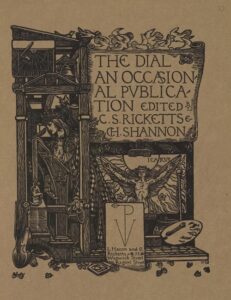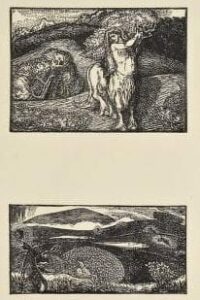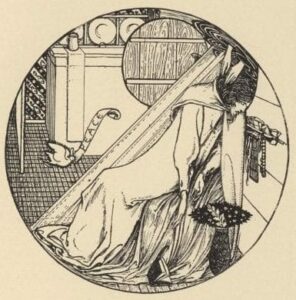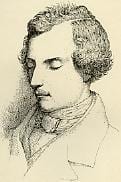The Centaur’s Place in The Dial as an Early Engagement of Symbolist Literature
Introduction
The Centaur is a French short story formerly written by Maurice de Guérin and then translated into English by Thomas Sturge Moore in the fifth volume of a little magazine known as The Dial. The story tells of a centaur, Macareus, imparting wisdom from his youth to his decaying old age to a legendary soothsayer and healer from Greek mythology, Melampus. The exact year that The Centaur was written remains unclear. Guérin died in 1839 of tuberculosis, not having published any work, and only gained recognition when his sister Eugénie and his friends published his work posthumously in 1840 (“Guérin, Maurice de”). It is only through the themes of old age and decay present in this short story that one can infer this story was written during the latter part of his life.

Its Presence in The Dial
What is this short story doing over 50 years later in an 1890s little magazine? When we compare Thomas Sturge Moore and Maurice de Guérin, we will notice distinct similarities in the motifs of their work. Thomas Sturge Moore was known to often weave symbols from ancient Greek myths and Christian bible stories into his work (Middleton 333). Guérin, on the other hand, rebelled against Roman Catholicism, and wrote in his journal of impactful discussions and studies living in a radical Christian community (“Guérin, Maurice de”). While the community was quickly dissolved, Guérin’s experiences with them could be seen as major influences in his life and his writing (“Guérin, Maurice de”).
How does Guérin’s story and its placement in The Dial magazine, with its use of hybridization with such elements as folklore and fantasy, mark a departure from the Decadence movement? The writing style differs from the classical story telling through its irreverence towards structure. It is a fantasy written as oral folklore, there is more prose than plot or other story elements in The Centaur, and its scenes place greater importance on their effect than their direct meaning. The cumulative effect of the attitudes and feelings throughout the Centaur’s story would ultimately measure, for Thomas Sturge Moore, a greater reverence for the values of the Symbolists over those of the Decadents.
Symbolism and Decadence
Symbolism was a movement that aimed for poets to use indirect suggestions, signs, and vague metaphors to communicate their emotions (Baldick 112). Rather than direct description or straightforward expression, authors would instead evoke sense impressions of inner life and experience (Baldick 112). Decadence is often compared as a sister movement to Symbolism and both of them can be seen to be heavily influenced from Baudelaire’s Les Fleurs du mal (1857), the work that eventually cultivated the fin de siècle culture of the 1880s and 1890s (Baldick 112). Decadent writers were characterized by their pride in loose moral standards and reverence for human creation (Pittock 105). According to Arthur Symons, such writers sought “a desperate endeavor to give sensation, to flash the impression of the moment, to preserve the very heat and motion of life” (Symons 7).
While Symbolism and Decadence can be seen as cohorts, it remains imperative to stress the differences they take in their attitude towards nature. While Decadent writers tend to belittle nature and find greater value in human creativity, Symbolists find a transcendental value in nature and often give the natural world high appraisal (Scott 57). Symons’ distinction in his essay, The Symbolist Movement, carries weight here: “The interlude, half a mock-interlude, of Decadence, diverted the attention of the critics while something more serious was in preparation. That something more serious has crystallised, for the time, under the form of Symbolism, in which art returns to the one pathway, leading through beautiful things to the eternal beauty” (7). These are the lens by which we must assess The Centaur and its place in the 1890s magazine.
Pagan Imagery

The image of a half-man, half-beast is commonly seen as pagan imagery. Guérin’s abandonment of the Christian God is seen further in his description of several polytheistic deities such as Apollo, Pan, Cybele, and Amphitrite. When the centaur sees a man making his way along the river, he even despises him, commenting on how short his steps are. It is rather mankind that serves as an affront to him; that man is just a centaur degraded by the gods. As far as symbols go, these would do very well to alienate the average 19th century reader in Europe. For an avant-garde 1890s magazine, such deities find a comfortable and fitting place for reverence.
Hybridity
Guérin expertly combines folklore and fantasy in this story. It is passed down to us as if it were an oratory tale. The story we read is of knowledge that is passed down from Chiron, to Macareus, to Melampus. However, Guérin uses this mythical creature as his expression. The half-man, half-beast hybrid emboldens that difficulty one faces being torn between one’s primal nature and one’s culture. Strength and consciousness here are haphazardly stitched together here, as if divine powers had presented their own Frankenstein’s monster that would see his beastly qualities wither away through time. The centaur’s youth is explosive and unrelenting compared to the languid torpor induced by his old age. The movement of his younger years he describes to Melampus as violent, that which made him as drunk as “some malignant liquor” (Guérin, The Centaur 47). The hybridity of this story is thusly used to juxtapose the struggles we face with contemplation and action, and how one inevitably swallows the other over time. In his essay Art and Life, Moore states style as a balance of all discordant tendencies, making the artist a healer that which is a bringer of true and harmonious descriptions that our soul yearns for (Middleton, 334). No stronger is the relevance to this idea seen than in a story that stitches together so many ostensibly opposing elements and ideas.

Wisdom in Nature
The bodies of water in the short story are motifs used to illustrate the power of nature over the centaur. The imagery we see of the centaur bathing in the river, his animal-half beneath the surface and his human-half above, signifies the mystical power water has over the
creature to balance its parts in equal measure. The water relaxes him, and also serves as a source of infinite wisdom for him. He describes them as “…more calm than the centaurs, and with a wisdom more beneficent than that of men” (Guérin, The Centaur 48). This is evident as well as he laments “…the old Ocean, father of all things, keepeth these secrets to himself…” (Guérin, The Centaur 48). Finally, he concludes that he will mingle with the rivers at the end of his life, he seeks a transcendental power from the natural world. Melampus went to the centaur for wisdom, and what he gained from his story can be surmised wholly by his inner experiences with nature: they provided him with an abstract, seemingly mystical knowledge that will eventually return to the earth in his death. The significance of some greater, hidden truth is yet another major idea distinctly lauded by the Symbolists (Scott 57). We see another instance of this repeated in the short story when Macareus believed he would be close to overhearing the dreams of Cybele, in hopes that the secrets might escape her – but only made out sounds or words “inarticulate as the bubbling hum of rivers” (Guérin, The Centaur 49).
That Macareus would describe his dark, cavernous youth as something that can be “recounted without difficulty” and that his underlying education that has so powerfully fostered him is attributed to the mountains (Guérin, The Centaur 47), would expound further Guérin’s respect towards nature and the unthinking mind. The consciousness he experiences in his old age on the other hand seems to strike him as an illness; it was only in his youth that he had tasted life “wholly pure” (Guérin, The Centaur 47). Yet again, we are inexorably forced to view this story’s place in The Dial as one harboring Symbolist qualities rather than Decadent ones as it vividly ilustrates the author’s reverence towards nature over the human mind.
Symbolism in Low Fantasy
In spite of this story involving many references to Greek mythology, many of its fantastical elements are stripped away by Guérin. Melampus, the legendary soothsayer and healer, no longer heals, and only seeks wisdom. The great centaur Chiron submits his immortality and returns to the laws of the natural world. Macareus too, patiently awaits his end. Each of these great mythical figures are stripped of their power and the magic and wonder of the other mentioned great Greek legends are only spoken of in past tense. While Guérin likely intended this as an emulation of his own decay from tuberculosis, its contextualization in the magazine contributes further to the ideas found in Symbolism. It provokes us to think of these characters in relation to his own life. Unable to cure or assuage his patient, a doctor is stripped away from his primary function. These are codes that could only wholly be decipherable by those with some knowledge of his personal life.

Conclusions
The Centaur’s place in The Dial can be seen as honouring a little-known writer that also took on the Symbolist ideas before they were formally incepted. His work’s participation in The Dial was seamless, both in its engagement with the ideas of the time as well as its ability to shock readers. One could compare Baudelaire and Guérin indeed as kindred spirits. Had he not passed away at the early age of 29, there would be no reason not to expect a greater influence from him on the Symbolist movement and European literature as a whole.
Works Cited
“Guerin, Maurice de.” Merriam Webster’s Encyclopedia of Literature. Merriam-Webster, 1995. Literature Resource Center, http://link.galegroup.com.ezproxy.lib.ryerson.ca/apps/doc/A148918355/LitRC?u=rpu_main&sid=LitRC&xid=6473a685
Baldick, Chris. Oxford Dictionary of Literary Terms. 3rd ed. Oxford University Press, 2008. Oxford Reference, http://www.oxfordreference.com.ezproxy.lib.ryerson.ca/view/10.1093/acref/9780199208272.001.0001/acref-9780199208272
Guerin, Maurice de. “The Centaur” The Dial, vol 2, translated by Thomas Sturge Moore. The Vale, 1897, pp. 16-21. Internet Archive, https://archive.org/stream/gri_33125014428227#page/n37
Middleton, David E. “Thomas Sturge Moore.” British Poets, 1880-1914. Stanford Gale, 1983, pp. 333-353. Literature Resource Center, http://link.galegroup.com.ezproxy.lib.ryerson.ca/apps/doc/H1200003337/LitRC?u=rpu_main&sid=LitRC&xid=2b46bf3d
Pittock, Murray. Spectrum of Decadence (Routledge Revivals): The Literature of The 1890s. Routledge, 2014. ProQuest, https://ebookcentral-proquest-com.ezproxy.lib.ryerson.ca/lib/ryerson/reader.action?docID=1757882
Scott, Clive. “The Poetry of Symbolism and Decadence.” Symbolism, Decadence, and the Fin de Siècle: French And European Perspectives. University of Exeter Press, 2000, pp. 57-71. Literature Resource Center, http://link.galegroup.com.ezproxy.lib.ryerson.ca/apps/doc/H1420060932/LitRC?u=rpu_main&sid=LitRC&xid=cf8272d4
Symons, Arthur. The Symbolist Movement In Literature. 2016. Project Gutenburg, http://www.gutenberg.org/files/53849/53849-h/53849-h.htm
Images in this online exhibit are either in the public domain or being used under fair dealing for the purpose of research and are provided solely for the purposes of research, private study, or education.
